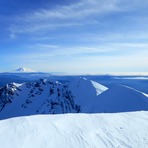Mount Saint Helens climbing notes shared by Mountain-Forecast users
Click here to submit your own climbing note for Mount Saint Helens
(NOTE: Texts may be edited by our content team for the purposes of ensuring accurate and relevant information)
-
October 15, 2015
Andy from United States
Mt St Helens is a geological wonder that should be on the bucket list of every hiker and climber. The impacts and aftermath of the eruption/explosion of 1980 are simply amazing and the stark beauty of the landscape is spectacular. A trip to the summit involves scrambling over boulder piles (lava flows) and climbing steep pumice slopes. There is a lot of variety on the route and it is quite rigorous, but when the weather is good the trip does not require technical mountaineering skills. The mountain is far more challenging during the winter and during bad weather including summer storms and bone-dry summer days when temperatures may be high and water unavailable. Climbing permits are required and anybody considering climbing the mountain needs to visit the non-profit Mount Saint Helens Institute web page for more information and to obtain a climbing permit.
-
June 02, 2013
Pippin from United States
Climbed St Helens on June 1st 2013. Trailhead to 6,500ft was warm with little wind. Wanted to wear shorts but knew what was ahead at higher elevations so left the snow pants on. Higher elevations were not cold unless standing still for more than 10 minutes, like at the summit.
Was advised that snow shoes were not necessary, which was correct, however, they would have been very handy from 5,500ft on; both up and down. This was particularly so on the descent since it was later in the day and the snow was soft. Did a lot of post-holing on the way down. Glisading was the preferable method.
The trip was exhausting and the crater was virtually invisible from the surrounding clouds but it was still well worth it.
(NOTE: Texts may be edited by our content team for the purposes of ensuring accurate and relevant information)
Andy from United States
Mt St Helens is a geological wonder that should be on the bucket list of every hiker and climber. The impacts and aftermath of the eruption/explosion of 1980 are simply amazing and the stark beauty of the landscape is spectacular. A trip to the summit involves scrambling over boulder piles (lava flows) and climbing steep pumice slopes. There is a lot of variety on the route and it is quite rigorous, but when the weather is good the trip does not require technical mountaineering skills. The mountain is far more challenging during the winter and during bad weather including summer storms and bone-dry summer days when temperatures may be high and water unavailable. Climbing permits are required and anybody considering climbing the mountain needs to visit the non-profit Mount Saint Helens Institute web page for more information and to obtain a climbing permit.
Pippin from United States
Climbed St Helens on June 1st 2013. Trailhead to 6,500ft was warm with little wind. Wanted to wear shorts but knew what was ahead at higher elevations so left the snow pants on. Higher elevations were not cold unless standing still for more than 10 minutes, like at the summit.
Was advised that snow shoes were not necessary, which was correct, however, they would have been very handy from 5,500ft on; both up and down. This was particularly so on the descent since it was later in the day and the snow was soft. Did a lot of post-holing on the way down. Glisading was the preferable method.
The trip was exhausting and the crater was virtually invisible from the surrounding clouds but it was still well worth it.


